Last night opened the annual visit of the Kirov Opera from the Mariinsky Theater of St. Petersburg, Russia, to the John F. Kennedy Center for the Performing Arts. They chose a fairly unknown work by Gioacchino Rossini called Il Viaggio a Reims, or "The Journey to Rheims." This particular production is a joint project with the Théâtre du Châtelet in France. Later, the Kirov will be doing Verdi's Falstaff and a concert version of Shostakovich's Lady Macbeth of Mtsensk.
Viaggio is the story of a group of disparate wealthy people travelling to Rheims for the coronation of the French king, and Rossini and his librettist Luigi Balocchi created a sweet, comedic amuse oreille. The opera was popular in its day (it premiered in 1825 in Italy), but then was forgotten until being resurrected in 1984. The Kirov has chosen to "update" the opera, setting it on a luxury ocean liner in the 1950s.
Every time I've gone to an opera at the Kennedy Center, I've sat down in the lower orchestra section, as close to the stage as I can get—I like to watch the singers work! Last night, though, I did something different and got tickets in the First Tier. There's a big difference in ticket prices: $175 for orchestra seats, with first tier seats running from $145 to $80. Alas, though, this was not the time to be in the balconies! The Kirov staged a good deal of the opera from the house, with a runway from the stage to the aisle that transects the orchestra section horizontally, and they also had stairs from the side aisles onto the corners of the stage. That effectively blocked the view from everybody in the center boxes (including the presidential box!) and the all of the balconies—over half of the house! Next time, I'll be back in the orchestra seating: I've learned my lesson.
The Kirov was avant garde in the rest of its staging, as well. The entire stage was covered in white. As we entered the Opera House, an enormous blue, white, and red flag hung diagonally across the stage. The performance started ten minutes late; when they began, we had ten minutes of people coming on and off the stage from all over the house as well as the stage, most dressed up in 1930s period clothing and carrying white-covered suitcases, and also including some domestics who appeared to be trying to clean up and sweep the stage floor with brooms and a working vacuum cleaner. There wasn't any dialogue during this period. Finally, Maestro Valery Gergiev walked on to the stage from the center runway, dressed in all black clothing, then the flag was ripped away and pulled quickly backstage to reveal the entire Orchestra of the Mariinsky Theater dressed in all white tail coats and white tie not in the pit but arranged on stage.
Having the orchestra on stage was an interesting decision for this opera. It had the expected problems of alignment between the singers and the orchestra, which didn't happen too often, but it did happen. I looked and looked to see if they had television monitors or something so the singers could watch the stick, but I never could find any. Since we weren't in the top balcony, I couldn't see down into the pit to see if there was a prompter or associate conductor down there relaying the beat.
But, thus started the opera. They continued to stage from all over the theater and the house, with singers in the orchestra, singers in various parts of the house, and singers in the boxes. A few times, they interacted with audience members in their vicinities.
Now, I have to confess that I don't know this opera. What's more, the program notes are scant and read as though they were written by a Russian who speaks some English. So, I'm not really able to tell who exactly who the starring characters are and by whom they were sung. I'm going to take a stab at this, though, and guess that the two characters who impressed me most were Modestina and the Contessa de Folleville, sung by Olga Legkova and Larusa Yudina. Modestina entered in a tight, fitted, bright red suit-dress ensemble with a matching hat. Yudina's character—a big-time clothes horse—stole the show several times with her stunning coloratura and some stratispherically high notes somewhere in the range of about a high E (sorry, I left my perfect pitch at home), and her costumes were incredible. Her entrance had her in a bold hot pink and black dress with a fully flared skirt and we soon saw dozens of servants carting in an enormous crate with several boxes inside that included her matching pink and black hat. In another scene, she entered completely enclosed in a floor length cape covered in bunches of beige tuille and with a matching high beehive hat, but—get this—the cape was illuminated from underneath.
Amongst the male singers, only the character playing the British lord—I think "Sidney"—caught my attention, sung by Eduard Tsanga.
Rossini wrote a few truly magical moments, including one ensemble for thirteen singers (I know that eight singers is an octet and nine singers is a nonet, but what is thirteen singers?) and then yet another for fourteen!
The production designers also made another interesting decision for the musicians. On the far left side of the stage, they placed a harpsichord to provide the continuo for the recitatives, and the harpsichordist was attired in all white 18th century attire with white powdered wig. Later, when a harp was needed as a soloist, a similarly attired harpist was wheeled out by the men of the chorus on a little platform to play during those arias; when one of the male singers had, in esssence, a "duet" with a flute, a similarly clad flutist came out and actually had complicated staging to interact with the singer.
There was a bit of a lull in the second act—too many love-lorn solos and love bird duets, you know—but on the whole, it was a light, frothy, enjoyable evening. Unfortunately, there are just two performances of this opera, last night and this afternoon, so you won't be able to see the production. That's a shame, cause this was a fun show and a wild, visual circus on stage.
Oh, and just as an aside, I was a bit disappointed when I went to the martini bar in the Grand Foyer during the interval and there was no Russian vodka!!!
Sunday, January 28, 2007
Sunday, January 21, 2007
Closing day
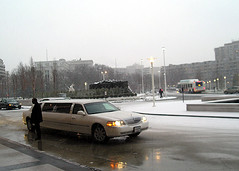

It was a magical moment to emerge from the stage door this afternoon to find Washington being gently blanketed with a light layer of snow!
Alas, I don't think we'll have any snow on the ground to speak of tomorrow morning. It's already stopped snowing and the streets and sidewalks aren't even covered. It's just been too warm around here of late. At least we finally got a little bit of winter weather this season.
We danced to our fifth sold-out house in a row this afternoon. It went well, as usual. The Juliet today, Evgenya Obraztosova, was very good, and she's probably my favorite of the lot this week. She's young at 23, but a lovely dancer and very, very expressive. The Romeo did his backwards fall down the steps from a crouching position.
Oh, I mentioned that one of my fellow supernumeraries had been an editor of Penthouse magazine. I discovered today that he was one of the founders of High Times magazine back in the 70s—and today he looks so preppy and bankerly! People I know who are former hippies and former (well, hopefully) potheads always tickle me. I'm so glad I'm a "generation Jones" person! I never could relate to the hippies. My generation's affectation was worshipping The Official Preppy Handbook and collecting Lacoste shirts. Which reminds me, I still have both a Polo shirt and a Tommy Hilfiger shirt from their original years of manufacture back in the late 70s and early 80s, plus an Abercrombie and Fitch tiny checked flannel shirt from the "outdoorsy" days before A & F went metrosexual.
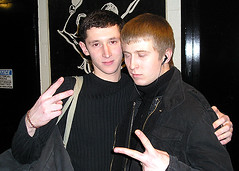 My knees are very sore tonight. When dancers do their "turn-out," they're supposed to turn their legs out from the hip joint, but when they are either untrained or out of practice, they often turn out from the knees, which is bad...I've obviously been turning out from my knees. :-( You know, most of these professional ballet danseurs start thinking about retirement once they hit 30. Did I mention I'm getting too old for this?
My knees are very sore tonight. When dancers do their "turn-out," they're supposed to turn their legs out from the hip joint, but when they are either untrained or out of practice, they often turn out from the knees, which is bad...I've obviously been turning out from my knees. :-( You know, most of these professional ballet danseurs start thinking about retirement once they hit 30. Did I mention I'm getting too old for this?So much to do now. I got very behind this week with the ballet.
Saturday, January 20, 2007
Long Saturday
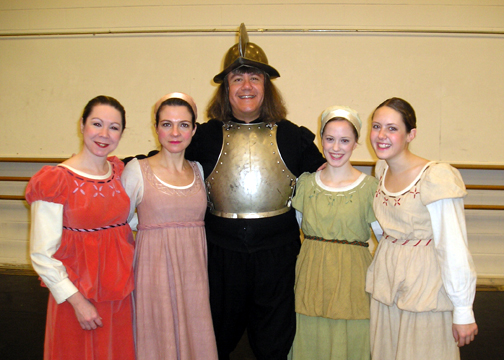
Two shows today. My feet are definitely cognizant of that fact tonight. One more show to go.
Neither of the Romeos today tried to match last night's full-height diver. Probably just as well....those Russians are very competitive, but matching last night's fall might get a principal dancer hurt.
There was a rumor that Laura Bush was in the audience this afternoon. I dunno. Everybody seemed to believe it, but I didn't see the security in place that would have been there for a public appearance of the First Lady.
Somebody gave us a bottle of Frangelico, so we sat around our dressing room sipping it during the second intermission.
We gave the ballet master a bottle of Kentucky bourbon, so he posed for a picture with us locals. He's standing just below me in the top middle of this picture:

Friday, January 19, 2007
Friday night full house
Wow, remember how I told you last Tuesday night about how during Romeo and Juliet's suicide scene, Romeo falls backwards down the stairs? The guys who've been dancing the part generally have been falling from either a low crouch or a kneeling position. Until tonight. Tonight's Romeo—a tall, gorgeous, blond boy—looked so distraught as he replaced Juliet on her bier (after carrying her all around balanced on one hand over his head), and then he stood to his full height, all the way up on the tips of his toes, and just leaned back and fell backwards down the steps like a diver on the high board. He elicited gasps from the audience, as well as from some of the people backstage.
Tonight's leading couple were pretty good. They came the closest so far to making me want to cry during their final scene. Maybe I should let that happen sometime, since it would be in character—my female partner and I, as mourners, come out with Juliet's parents in the very last minute of the ballet to gaze upon the unfortunate couple as the curtain falls.
During tonight's sword fight, Tybalt accidentally nicked Mercutio (I told you these were real and not just stage movement), and that seriously pissed off Mercutio, so the sword fight got very hard and vigorous. When Tybalt came off stage after "killing" Mercutio, he threw down his sword and bent over, gasping for breath, and holding his over-worked sword arm in pain. He recovered before going back out to have his terminal swordfight with Romeo. Ah, the joys of live theater.
I learned some interesting new bits of trivia this week:Oh, while I was walking over to the Kennedy Center, I passed by Condoleeza Rice walking on the sidewalk outside the Watergate (where she lives), talking with one man and accompanied by two Secret Service agents. As I passed by, I nodded and said, "Madam Secretary," and she paused, looked at me, and said, "Oh, hiiiiii!" Yeah, I'm sure she recognized me. Uh-huh.
Three more shows to go. Tomorrow will be a long day.
Tonight's leading couple were pretty good. They came the closest so far to making me want to cry during their final scene. Maybe I should let that happen sometime, since it would be in character—my female partner and I, as mourners, come out with Juliet's parents in the very last minute of the ballet to gaze upon the unfortunate couple as the curtain falls.
During tonight's sword fight, Tybalt accidentally nicked Mercutio (I told you these were real and not just stage movement), and that seriously pissed off Mercutio, so the sword fight got very hard and vigorous. When Tybalt came off stage after "killing" Mercutio, he threw down his sword and bent over, gasping for breath, and holding his over-worked sword arm in pain. He recovered before going back out to have his terminal swordfight with Romeo. Ah, the joys of live theater.
I learned some interesting new bits of trivia this week:Oh, while I was walking over to the Kennedy Center, I passed by Condoleeza Rice walking on the sidewalk outside the Watergate (where she lives), talking with one man and accompanied by two Secret Service agents. As I passed by, I nodded and said, "Madam Secretary," and she paused, looked at me, and said, "Oh, hiiiiii!" Yeah, I'm sure she recognized me. Uh-huh.
Three more shows to go. Tomorrow will be a long day.
Review's in
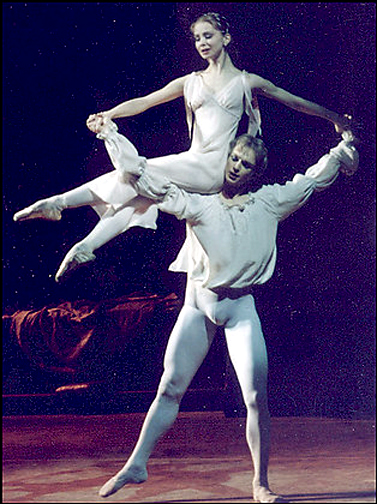
The review of Romeo and Juliet finally showed up in this morning's paper.
Click here to read the Washington Post review.
Performance #3 is over and went well. I particularly liked the Romeo tonight (there are four sets of Romeos and Juliets who take turns during the one dress rehearsal and seven performances).
I am continuing to survive. Good thing I brought my own arch supports Tuesday to wear inside my ballet slippers. Everyone's feet are starting to bother them.
Did I mention I get to carry around this really heavy pike? The weapon, that is, not the fish.
Thursday, January 18, 2007
Channelling Cleopatra

Do you think I look like Elizabeth Taylor in Cleopatra? (Yes, I know it's a dreadful picture.)
Romeo and Juliet #2 went just fine. Actually, after opening night of any production, I always find that things quickly fall into a routine, so my challenge is always maintaining focus and keeping my performance just as fresh late in the run as it was for the audience on opening night.
Those of you who've done plays, musicals, operas, or ballets with either guest artists or touring companies know how the backstage areas are peppered with signs pointing out directions to this, that, or the other. This production is no different, only all of the signs are in Russian, using the Cyrillic alphabet. I am, therefore, constantly lost, since there are no English signs telling me where to go (hence I've not yet gone downstairs to the artists and crew canteen to eat).
The other problem is that all of the calls are in Russian! That means that when the stage manager gets on the backstage PA system to say how much time we have before curtain or who is being called to the stage to get ready for an entrance, I can't understand a word! My Russian is limited to yes, no, hello, goodbye, thank you, and vodka, and I've yet to hear any of those words during the calls.
There is a dancer in the corps who looks just like my friend Justin, except he's shorter and his hair is dark brown.
I took a few more pictures last night, though not many. Rather than post them here, I'm going to put them in a Flickr album and you can click the link to view them if you so desire.
Wednesday, January 17, 2007
Surviving the Prima
We opened Romeo and Juliet last night to a full house and a very appreciative crowd. Meanwhile, this morning, I could barely walk when I got out of bed this morning.
It's always a challenge to step into these touring companies and prepare for openings with both a dress rehearsal and a performance on the same day. I guess it's all a function of cash flow, especially at highly union houses like the Kennedy Center, where they have to cut costs and hold expenses down at every opportunity. We locals aren't being paid all that much, but to bring us in for more rehearsals or more days involves all kinds of union dancers, musicians, directors, stage and backstage crew, and other support personnel, not to mention additional housing, food, and travel costs for the touring company artists. Thus, we end up, essentially, dancing two ballets in one day.
Not a problem, I suppose, for the young teens and twenty-somethings who dance and train daily, but I'm twice their age and haven't danced since July 2005, and it's days like yesterday that make me think I'm getting too old for this sort of thing.
Since it's not in the production budget, I'm still seeking volunteers to buy/give me a massage!
We got wigs yesterday. For acts I and II, I have a lovely, mouse brown, page boy. In act III, I change characters, hence hair, and move into a black wig; I'm told it makes me look like Elizabeth Taylor in Cleopatra.
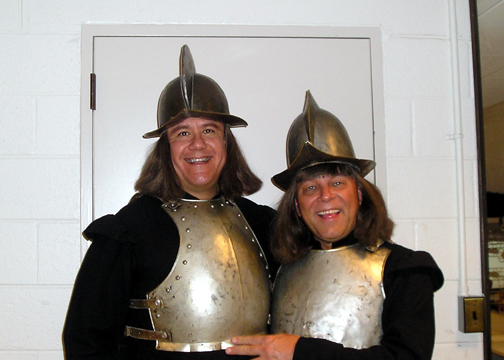
Now, a few notes about the production. This is a great show.
Everybody knows the "Romeo and Juliet" story (this is one of the first events in D.C.'s year-long Shakespeare in Washington festival). The music is from the Sergei Prokofiev 1936 score that was actually commissioned by the Kirov Ballet. Because of several orchestral suites from the score often played at classical concerts and the use of themes in various movies and television show sound tracks, many people will recognize bits and pieces of the music. The 1940 Leonid Lavrovsky choreography used this week also originated with the Kirov.
The stage director has done a great job with the large, busy, interesting crowd scenes. There is lots going on simultaneously and it never feels stilted (often a great problem for "fake-feeling" ballet crowd scenes). Costumes are lavish and varied.
The Kirov is a very athletic dance company with a big (and competitive) group of male dancers, so you'll see a lot of spectacular choreography for them. There is a lot of sword fighting in this show, and it's actual swordfighting, not just "stage movement."
The various Romeos (there are four who rotate throughout the week) have a lot of work to do lifting and holding their Juliets above their heads, including one scene where Romeo lifts and balances Juliet with just one hand. And, when Romeo dies at Juliet's bier, he has to fall backwards down the stairs!
There is a definite advantage to the Soviet/Russian tradition of identifying and training dancers from the time their are pre-school aged children. They develop levels of technique and flexibility I can't imagine in many of the American dancers and athletes I know. For example, I like to watch the dancers stretch and warm-up before dressing for a show. "Paris" walked in to the rehearsal room and the very first thing he did was stand in one place and then lift his leg straight up until his toes pointed directly at the ceiling; then he switched legs. I saw one of the "Romeos" preparing, as well. He was sitting on the mat with his legs spread apart from side to side at a 180º angle. Note that I said from side to side, not from front to back.
Lots of people are involved behind the scenes in putting this show together. Here are my dresser, makeup artist, wigger, and armorer:

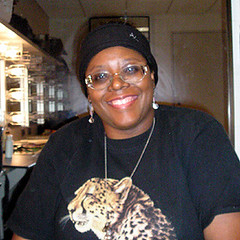
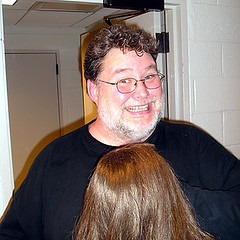

It's always a challenge to step into these touring companies and prepare for openings with both a dress rehearsal and a performance on the same day. I guess it's all a function of cash flow, especially at highly union houses like the Kennedy Center, where they have to cut costs and hold expenses down at every opportunity. We locals aren't being paid all that much, but to bring us in for more rehearsals or more days involves all kinds of union dancers, musicians, directors, stage and backstage crew, and other support personnel, not to mention additional housing, food, and travel costs for the touring company artists. Thus, we end up, essentially, dancing two ballets in one day.
Not a problem, I suppose, for the young teens and twenty-somethings who dance and train daily, but I'm twice their age and haven't danced since July 2005, and it's days like yesterday that make me think I'm getting too old for this sort of thing.
Since it's not in the production budget, I'm still seeking volunteers to buy/give me a massage!
We got wigs yesterday. For acts I and II, I have a lovely, mouse brown, page boy. In act III, I change characters, hence hair, and move into a black wig; I'm told it makes me look like Elizabeth Taylor in Cleopatra.

Now, a few notes about the production. This is a great show.
Everybody knows the "Romeo and Juliet" story (this is one of the first events in D.C.'s year-long Shakespeare in Washington festival). The music is from the Sergei Prokofiev 1936 score that was actually commissioned by the Kirov Ballet. Because of several orchestral suites from the score often played at classical concerts and the use of themes in various movies and television show sound tracks, many people will recognize bits and pieces of the music. The 1940 Leonid Lavrovsky choreography used this week also originated with the Kirov.
The stage director has done a great job with the large, busy, interesting crowd scenes. There is lots going on simultaneously and it never feels stilted (often a great problem for "fake-feeling" ballet crowd scenes). Costumes are lavish and varied.
The Kirov is a very athletic dance company with a big (and competitive) group of male dancers, so you'll see a lot of spectacular choreography for them. There is a lot of sword fighting in this show, and it's actual swordfighting, not just "stage movement."
The various Romeos (there are four who rotate throughout the week) have a lot of work to do lifting and holding their Juliets above their heads, including one scene where Romeo lifts and balances Juliet with just one hand. And, when Romeo dies at Juliet's bier, he has to fall backwards down the stairs!
There is a definite advantage to the Soviet/Russian tradition of identifying and training dancers from the time their are pre-school aged children. They develop levels of technique and flexibility I can't imagine in many of the American dancers and athletes I know. For example, I like to watch the dancers stretch and warm-up before dressing for a show. "Paris" walked in to the rehearsal room and the very first thing he did was stand in one place and then lift his leg straight up until his toes pointed directly at the ceiling; then he switched legs. I saw one of the "Romeos" preparing, as well. He was sitting on the mat with his legs spread apart from side to side at a 180º angle. Note that I said from side to side, not from front to back.
Lots of people are involved behind the scenes in putting this show together. Here are my dresser, makeup artist, wigger, and armorer:




Monday, January 15, 2007
Standing in first position
Last Friday afternoon, I got a call from the Kennedy Center wanting me to come over this afternoon to audition for a bit part for their Kennedy Center Ballet Series. The Mariinski Ballet of the Mariinski Theater of St. Peterburg, Russia, more commonly known around here by its Soviet name as the Kirov Ballet, is dancing a production of Prokofiev's Romeo and Juliet.
So, after spending the weekend constantly stretching and carefully watching what I was eating (including not eating at all today) so I could lose at least a little bit of weight, I wandered over. The Kennedy Center was a madhouse! Shows were scheduled in all the houses tonight, including this great big MLK concert that had people standing in a enormous line winding up and down the lobby to get free tickets. Then, the audition group, which I expected to be small, was huge! They were casting a dozen guys and eight females, but there had to have been over sixty people queing up and filling out forms.
At the appointed hour, they led everyone in single file backstage onto the Opera House stage. As I entered, I espied the ballet master, so I shouted out a quick "privyet" (hello in Russian) to him.
We did our thing. And I got cast.
As a matter of fact, I got double cast. Both were iffy.....the wardrobe people didn't really want me cause I'm too big for their costumes, but the ballet master did, and he won. I'm going to be a "warrior" in acts I and II and a "mourner" at the end of act III. The only problem, aside from having to stand for five minutes at a stretch in first position (legs turned out, heels together, and feet pointed apart at a 180º angle)? The costume.
My costume is this heavy, black wool jacket with black wool short pants worn over black tights, and, on top of that, I have real metal armor—a helmet and one of those heavy front and back molded torso coverings—to wear on top of the woolens. So, I was melting. My "mourner" outfit is basically the same—all black woolens—plus a black three-quarter length cape.
I'm just in from rehearsal tonight. Dress rehearsal is tomorrow afternoon, and then we open tomorrow night at 7:30. Looks like I'm going to be spending my week at the Kennedy Center, since we've performances every night through Saturday plus matinees on Saturday and Sunday.
Meanwhile, I need a massage.
So, after spending the weekend constantly stretching and carefully watching what I was eating (including not eating at all today) so I could lose at least a little bit of weight, I wandered over. The Kennedy Center was a madhouse! Shows were scheduled in all the houses tonight, including this great big MLK concert that had people standing in a enormous line winding up and down the lobby to get free tickets. Then, the audition group, which I expected to be small, was huge! They were casting a dozen guys and eight females, but there had to have been over sixty people queing up and filling out forms.
At the appointed hour, they led everyone in single file backstage onto the Opera House stage. As I entered, I espied the ballet master, so I shouted out a quick "privyet" (hello in Russian) to him.
We did our thing. And I got cast.
As a matter of fact, I got double cast. Both were iffy.....the wardrobe people didn't really want me cause I'm too big for their costumes, but the ballet master did, and he won. I'm going to be a "warrior" in acts I and II and a "mourner" at the end of act III. The only problem, aside from having to stand for five minutes at a stretch in first position (legs turned out, heels together, and feet pointed apart at a 180º angle)? The costume.
My costume is this heavy, black wool jacket with black wool short pants worn over black tights, and, on top of that, I have real metal armor—a helmet and one of those heavy front and back molded torso coverings—to wear on top of the woolens. So, I was melting. My "mourner" outfit is basically the same—all black woolens—plus a black three-quarter length cape.
I'm just in from rehearsal tonight. Dress rehearsal is tomorrow afternoon, and then we open tomorrow night at 7:30. Looks like I'm going to be spending my week at the Kennedy Center, since we've performances every night through Saturday plus matinees on Saturday and Sunday.
Meanwhile, I need a massage.
Wednesday, January 10, 2007
ABT: Mixed Repertory
The American Ballet Theater is making its annual visit to the Kennedy Center this week and Kevin and I went to their opening night performance last night to see their Mixed Repertory concert, presenting a modern American icon, an act from a classical ballet, and a contemporary work. This weekend, they will also be doing a full length Othello as part of the 2007 citywide "Shakespeare in Washington" festival.
The Kennedy Center Opera House Orchestra was in the pit under the direction of Ormsby Wilkins for the first two acts and Charles Barker for the third act. The orchestra played splendidly and never distracted me with errrors or tonal problems. Both the harpist and the violin concertmaster had particularly lovely solo moments.
The concert opened with Act II of La Bayadère, or "The Kingdom of the Shades." The curtain rose to a long, single-file procession of two dozen corps de ballet dancers in white, formal tutus coming down the mountain and then crossing back and forth across the stage until it was filled. This was very much a ballet choreographed in the traditional, classical Russian style. Principal dancers Paloma Herrera and Jose Manuel Carreño appeared as Nikiya and Solor, Carreño to great audience acclaim.
As is common with ballet companies, they really milk the curtain calls. In this case, there was a full company bow, then the curtain went down only to come up again as the applause was dying out to reveal the corps on stage, followed by entrances for the soloists and then the two principals. The curtain went down again and the applause stopped, when they parted the curtain to permit the two principals come out for a solo bow, requiring everyone to have to start clapping again. Now, it's not that we aren't appreciative of the artistry or efforts of the dancers, but these long, "scripted," curtain calls do get rather tiresome; ABT, of course, is not alone in this practice, but all dance companies could stand to have greater sensitivity to audience reactions.
The second act of the concert, called "Dark Elegies," was rather unusual. The music came from the song cycle by Gustav Mahler called Kindertotenlieder, or "Songs on the Death of Children." The cycle is a well-known part of the baritone lieder repertoire, but I've never thought of it as a topic for ballet. Baritone Troy Cook sang the five songs, in costume and seated on a rustic bench placed far downstage left. The program said nothing about Cook other than his name; I've not worked with or heard him before. He's a very slender man, looking to be about average height (he was just a tiny bit taller than the dancers during the curtain call), with a pleasant and expressive, light, lyric baritone voice. The top on these songs is not terribly demanding for a baritone, with quite a few high Fs in the lyrical line (but none major), and in one song there are a couple of not-terribly-important G-flats (F-sharps). The challenge, though, is that in every Mahler song I've ever done, Mahler always demands a full two-octave range from his performers, and, as in Kindertotenlieder, often just a little more. That's the case here, as well, only the real challenge for the baritone soloist is that in one of the songs, several phrases start and stop on a low F. Low Fs are not usual baritone notes; in fact, I try to avoid anything below a B-flat or an A so that I can be heard. Not surprisingly, those Fs and Gs were difficult for Cook, but I was, at least, able to hear them. Overall, his performance was sensitive and quite fine, and I often found myself watching him instead of the dancers.
Speaking of dancers, well, it was different. This was one of those so-called "modern" things, though the ballet originated in 1937. Naturally, one would not expect a bunch of happy, ecstatic jumping around to songs about bereaved parents, so this was a work of quiet posturing and slow movements. The women were clad in matronly looking dresses and bonnets with the men in simple dance trousers, white shirts with the sleeves rolled up to the elbows, and sleeveless sweater vests. Principals Michele Wiles and Julie Kent danced, but I wasn't particularly wowwed (it was the choreography, not them). Company soloist Carlos Lopez, however, had a lovely solo moment, and he's clearly on the fast track to principal.
Americans who watch a lot of television will undoubtedly recognize the score for the third act. For many years, the National Cattlemen's Beef Association has run a commercial with the tag line, "Beef. It's what's for dinner." and that commercial makes use of Aaron Copeland's brilliant score for his 1942 ballet, Rodeo (traditionally pronounced the Spanish, not American way, although Copeland himself used the American pronunciation).
Rodeo is a fun ballet, and the audience loved it. It starts with the cowhands in the corral in the afternoon and ends with a love story and a dance in the evening. The poignant comic relief comes in the form of the young tom girl, danced humorously by peppy principal Xiomara Reyes, who tries to get the men's attention by being a cowgirl and being "one of the guys," instead of giggling, putting on airs, and wearing a dress like all the other girls. The head wrangler, Isaac Stappas (why isn't this wonderful dancer at least a soloist?) has eyes for her, but she gets distracted by the egotistic bravado of the Champion Roper, soloist Sascha Radetsky. If you ever wondered why dance students are taught both classic and tap dance, this is the ballet that will explain that question. Also, I must say that in all the rodeos I've attended (not to mention all the cowboys I've known), I've never seen cowboys in pastel jeans, especially pastel orange or most especially pastel pink!
As always, American Ballet Theater demonstrated why they are considered one of the very top dance companies in the country with a very enjoyable and entertaining evening. I only wish my schedule permitted me to see their Othello this weekend; perhaps on another tour.
_________________________
The intermissions seemed a little longer than usual, but we didn't cocktail. Surprisingly, I didn't see a soul I knew in the audience. Kevin, however, saw and talked to a beautiful young woman named Claire who's been in some of his classes up in College Park. I suspect she was a ballerina in her youth.
The Kennedy Center Opera House Orchestra was in the pit under the direction of Ormsby Wilkins for the first two acts and Charles Barker for the third act. The orchestra played splendidly and never distracted me with errrors or tonal problems. Both the harpist and the violin concertmaster had particularly lovely solo moments.
The concert opened with Act II of La Bayadère, or "The Kingdom of the Shades." The curtain rose to a long, single-file procession of two dozen corps de ballet dancers in white, formal tutus coming down the mountain and then crossing back and forth across the stage until it was filled. This was very much a ballet choreographed in the traditional, classical Russian style. Principal dancers Paloma Herrera and Jose Manuel Carreño appeared as Nikiya and Solor, Carreño to great audience acclaim.
As is common with ballet companies, they really milk the curtain calls. In this case, there was a full company bow, then the curtain went down only to come up again as the applause was dying out to reveal the corps on stage, followed by entrances for the soloists and then the two principals. The curtain went down again and the applause stopped, when they parted the curtain to permit the two principals come out for a solo bow, requiring everyone to have to start clapping again. Now, it's not that we aren't appreciative of the artistry or efforts of the dancers, but these long, "scripted," curtain calls do get rather tiresome; ABT, of course, is not alone in this practice, but all dance companies could stand to have greater sensitivity to audience reactions.
The second act of the concert, called "Dark Elegies," was rather unusual. The music came from the song cycle by Gustav Mahler called Kindertotenlieder, or "Songs on the Death of Children." The cycle is a well-known part of the baritone lieder repertoire, but I've never thought of it as a topic for ballet. Baritone Troy Cook sang the five songs, in costume and seated on a rustic bench placed far downstage left. The program said nothing about Cook other than his name; I've not worked with or heard him before. He's a very slender man, looking to be about average height (he was just a tiny bit taller than the dancers during the curtain call), with a pleasant and expressive, light, lyric baritone voice. The top on these songs is not terribly demanding for a baritone, with quite a few high Fs in the lyrical line (but none major), and in one song there are a couple of not-terribly-important G-flats (F-sharps). The challenge, though, is that in every Mahler song I've ever done, Mahler always demands a full two-octave range from his performers, and, as in Kindertotenlieder, often just a little more. That's the case here, as well, only the real challenge for the baritone soloist is that in one of the songs, several phrases start and stop on a low F. Low Fs are not usual baritone notes; in fact, I try to avoid anything below a B-flat or an A so that I can be heard. Not surprisingly, those Fs and Gs were difficult for Cook, but I was, at least, able to hear them. Overall, his performance was sensitive and quite fine, and I often found myself watching him instead of the dancers.
Speaking of dancers, well, it was different. This was one of those so-called "modern" things, though the ballet originated in 1937. Naturally, one would not expect a bunch of happy, ecstatic jumping around to songs about bereaved parents, so this was a work of quiet posturing and slow movements. The women were clad in matronly looking dresses and bonnets with the men in simple dance trousers, white shirts with the sleeves rolled up to the elbows, and sleeveless sweater vests. Principals Michele Wiles and Julie Kent danced, but I wasn't particularly wowwed (it was the choreography, not them). Company soloist Carlos Lopez, however, had a lovely solo moment, and he's clearly on the fast track to principal.
Americans who watch a lot of television will undoubtedly recognize the score for the third act. For many years, the National Cattlemen's Beef Association has run a commercial with the tag line, "Beef. It's what's for dinner." and that commercial makes use of Aaron Copeland's brilliant score for his 1942 ballet, Rodeo (traditionally pronounced the Spanish, not American way, although Copeland himself used the American pronunciation).
Rodeo is a fun ballet, and the audience loved it. It starts with the cowhands in the corral in the afternoon and ends with a love story and a dance in the evening. The poignant comic relief comes in the form of the young tom girl, danced humorously by peppy principal Xiomara Reyes, who tries to get the men's attention by being a cowgirl and being "one of the guys," instead of giggling, putting on airs, and wearing a dress like all the other girls. The head wrangler, Isaac Stappas (why isn't this wonderful dancer at least a soloist?) has eyes for her, but she gets distracted by the egotistic bravado of the Champion Roper, soloist Sascha Radetsky. If you ever wondered why dance students are taught both classic and tap dance, this is the ballet that will explain that question. Also, I must say that in all the rodeos I've attended (not to mention all the cowboys I've known), I've never seen cowboys in pastel jeans, especially pastel orange or most especially pastel pink!
As always, American Ballet Theater demonstrated why they are considered one of the very top dance companies in the country with a very enjoyable and entertaining evening. I only wish my schedule permitted me to see their Othello this weekend; perhaps on another tour.
The intermissions seemed a little longer than usual, but we didn't cocktail. Surprisingly, I didn't see a soul I knew in the audience. Kevin, however, saw and talked to a beautiful young woman named Claire who's been in some of his classes up in College Park. I suspect she was a ballerina in her youth.
Saturday, January 6, 2007
Christmas is over

Today is the Feast of the Epiphany, the day the church commemorates the three wise men who travelled from the east to visit the Christ Child, and it ends the Christmas season (tonight is Twelfth Night, when the Christmas tree bonfires are done and today is the Twelfth Day of Christmas from the popular carol). I have to take down all the decorations and tree now. Other things on today's calendar, if I don't go back to bed and sleep through them (I woke up at 3:30 this morning and I'm still up), include Epiphany Mass at 11 and the Metropolitan Opera's broadcast to selected movie theaters all over the country of Bellini's opera I Puritani at 1:30.
So, why the picture above? Well, that's a picture of nephew Ryan last month explaining a painting at the National Gallery of Art by Fra Angelico and Fra Filippo Lippi ca. 1445 called "The Adoration of the Magi." It's actually considered to be a very important painting, not for its religious significance (especially today, Epiphany), but because it's considered to be the bridge between medieval and Renaissance symbolism in painted art. Quite by coincidence, Ryan wrote a paper on this painting for one of his art history classes last spring. We made a point to take his picture by it last month, since he has the same professor once again for another art history class this term, and the photo was a great way to suck up to the professor.
I also had some pictures of me taken in the late medieval and early Renaissance galleries. Had some good pictures of the famous Giotto painting, but I looked hideous in them, so we had to select some lesser-known artists. Below is a picture of me standing by a triptych of Mary and Baby Jesus called "Madonna Enthroned with Saints and Angels" done ca. 1380 by Agnolo Gaddi. As you can see, I wasn't very photogenic that day. This was going to be my Christmas card photo—why buy a card with a Madonna and Child on it when one can have a photo of oneself by one of the famous Madonna and Child paintings? It was great logic. I never did, however, get around to sending Christmas cards last month. Oh, well.
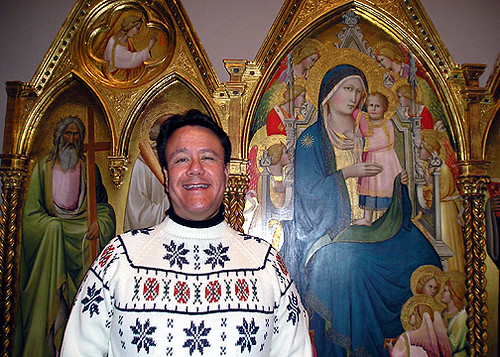
Subscribe to:
Comments (Atom)
